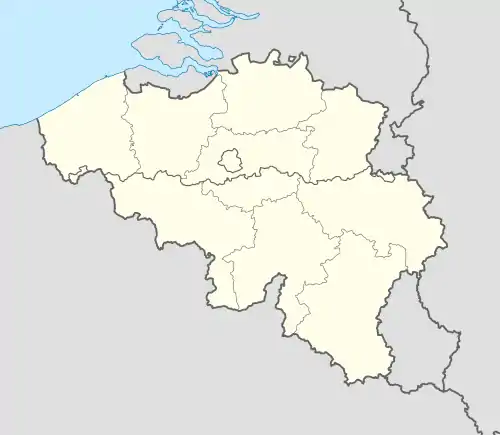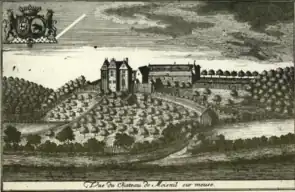Andenne
| |
|---|---|
.jpg.webp) | |
 Flag .svg.png.webp) Coat of arms | |
Location of Andenne | |
 Andenne Location in Belgium
Location of Andenne in Namur Province  | |
| Coordinates: 50°29′N 05°06′E / 50.483°N 5.100°E | |
| Country | |
| Community | French Community |
| Region | Wallonia |
| Province | Namur |
| Arrondissement | Namur |
| Government | |
| • Mayor | Claude Eerdekens (PS, PSD@) |
| • Governing party/ies | PSD@ |
| Area | |
| • Total | 86.11 km2 (33.25 sq mi) |
| Population (2020-01-01)[1] | |
| • Total | 27,573 |
| • Density | 320/km2 (830/sq mi) |
| Postal codes | 5300 |
| NIS code | 92003 |
| Area codes | 085 and 081 |
| Website | www.andenne.be |
Andenne (French pronunciation: [ɑ̃.dɛn] ⓘ; Walloon: Andene) is a city and municipality of Wallonia located in the province of Namur, Belgium.
On January 1, 2006, Andenne had a total population of 25,240. The total area is 86.17 km² which gives a population density of 292 inhabitants per km². The municipality, and the central city, extend on both sides of the river Meuse.
The municipality consists of the following districts: Andenne, Bonneville, Coutisse, Landenne, Maizeret, Namêche, Sclayn, Seilles, Thon-Samson, and Vezin.
History
The city is symbolized by a bear, originating from the legend that saw Charles Martel, while still a child, use a hammer to kill a bear that terrorized the inhabitants.
Andenne is the location of the Château du Moisnil.
Andenne is associated with the Rape of Belgium in 1914, during which between 211 and 225 townspeople were massacred. German troops entered the area on August 18, 1914 but discovered all the bridges into town had been blown to deny them crossing. Construction of a pontoon bridge commenced, and the next day the Germans entered. At first no serious conflicts arose; apart from some German soldiers looting shops, mainly taverns and inns. Civilians were frightened and hid. When the main army arrived the civilians began panicking causing them to be rounded up and forced out into the streets. From there they were taken to the main square, where they were berated for what Belgian soldiers and civilians had done to the German's "brothers". As revenge all were shot, or killed with axes.
One German soldier's diary was discovered near Andenne, stating: "19th August, Our cavalry patrols, we hear, are being shot at in the villages again and again. Several poor fellows have already lost their lives. Disgraceful! An honest bullet in honest battle – yes, then one has shed one’s blood for the Fatherland. But to be shot from an ambush, from the window of a house, the gun barrel hidden behind flowerpots, no, that is not a nice, soldierly death."
Notable individuals
- Saint Begga (613–693), daughter of Pepin of Landen and mother of Pepin of Herstal. She founded a convent in Andenne of which she was the first abbess. She is buried in Saint Begga's Collegiate Church in Andenne.
- Gertrude of Nivelles, (ca.628–659), abbess, who, with her mother Itta, founded the Nivelles Abbey; younger sister of St. Begga.[2]
- Carl Johan Frederik Jakhelln (1914–1987), Norwegian diplomat and writer
- Fats Sadi (1927–2009, Huy), jazz musician
- Cécile de France (born 1975), actress
Gallery
 The Meuse river
The Meuse river The City Hall
The City Hall Place des Tilleuls – The kiosk (1879)
Place des Tilleuls – The kiosk (1879) St. Begge Collegiate
St. Begge Collegiate The St. Begge fountain
The St. Begge fountain Office du Tourisme – "Art Nouveau" house (1907)
Office du Tourisme – "Art Nouveau" house (1907) St. Begge house (1623)
St. Begge house (1623) Classical house called "Maison de Chanoinesses"
Classical house called "Maison de Chanoinesses" Old engraving of the Château du Moisnil in Andenne
Old engraving of the Château du Moisnil in Andenne
See also
References
- ↑ "Andenne". Statbel. Retrieved 2 March 2021.
- ↑ Ott, Michael (1909). . Catholic Encyclopedia. Vol. 6.
External links
